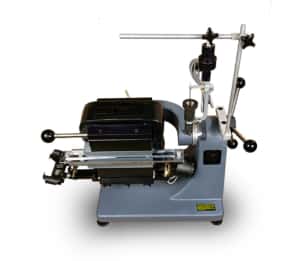Our LB-1 Magnetic Barrier Laboratory Separators exploit either paramagnetic or diamagnetic properties to separate dry materials according to magnetic susceptibility. They deliver more than 3.5 times the magnetic separating force of the Isodynamic® Separator, provide improved particle feed and transport systems, and allow the separation to be observed.
HOW THE LB-1 MAGNETIC BARRIER LABORATORY SEPARATOR WORKS
- Material is fed through the hopper, which provides adjustable, stable flow into a suitable feed trough and then onto the chute.
- Material is deflected by opposed magnetic and non-magnetic (gravitational) forces, controlled by the current and side slope respectively. This process is visible in front of the pole pieces.
- Continuous deflection as the material moves down the chute separates particles of the desired susceptibility.
- Material is physically segregated by a divider on the chute near the end of the separating space.
- Segregated materials are discharged into separate receiving containers.
NOTE: Material paths along the surface of the chute are parallel to the midplane between the opposed faces of the pole pieces, perpendicular to the magnetic flux path. Near the midplane, where the material undergoes separation, the magnetic force attracting the particles toward either pole piece is negligible, no matter how strongly they are magnetized.
The magnetic energy gradient H(dH/dX) in the separating region of the Barrier field has a pattern that may be likened to a packet of thin sheets, perpendicular to the midplane, with their surfaces aligned with the lengthwise axis of the gap between the pole pieces. Along the length of each sheet, the magnetic energy gradient transverse-to-field direction is constant. Across the width of the separating region, the magnetic energy gradient transverse-to-field direction rises from sheet to sheet, from low values at the outer fringes of the field to maximum value at a sheet near the center of the separating region (located just outside of the space between the pole faces). This is the magnetic barrier. As the material encounters this barrier, if its magnetic susceptibility is high enough, it will be deflected along this sheet. If not, it will pass through.
Conventional vs. Barrier Force Separators
Conventional separators employ magnetic force aligned with field direction to attract particles toward magnetized collecting surfaces. The magnetic force has a maximum value at such surfaces and decreases rapidly with distance from the surface. The force experienced by any particle in a conventional separator depends on the accident of its position in the field. Particles passing close to a surface may be captured, while particles of identical properties passing farther away may escape.
The Barrier technology on the other hand, by providing conditions in which particles of like susceptibility encounter like magnetic force per unit volume along any of the thin sheets described above, has inherent advantages in selectivity and sensitivity for separating materials according to slight differences in susceptibility.
CONVERSION OF ISODYNAMICS TO BARRIER SEPARATORS
Company founder Samuel G. Frantz pioneered the science of magnetic separation technology, engineering the Frantz Isodynamic® Separator, which became the leading device for separation according to magnetic susceptibility.
Because the Frantz Isodynamic® Separator has a virtually unlimited useful life, elements of the LB-1 Magnetic Barrier Laboratory Separator were consequently designed so that all parts can be installed in the base and the magnetic circuit of any Isodynamic® Separator to convert it to a Barrier Separator.
All necessary parts and instructions are available as a kit to upgrade any Isodynamic® to a Barrier Separator. The conversion can be made by anyone with minimal technical skills by following the directions supplied. The Isodynamic® Separator, serial number 1, manufactured in 1935 was upgraded to a Barrier Separator by the company in 1989.
TYPICAL MAGNETIC BARRIER LABORATORY SEPARATOR APPLICATIONS
Our LB-1 Magnetic Barrier Laboratory Separators are commonly used in:
- Geological Investigation – Since its introduction in 1986, the LB-1 has come into widespread use by agencies such as the USGS to separate the component species of mineral samples according to susceptibility, commonly replacing the Frantz Isodynamic® Separator.
- Geochronology – Used by the Geological Survey of Canada, barrier separators exploit the low paramagnetic and diamagnetic susceptibilities of pyrites, zircon, and other minerals which, for the most part, report as nonmagnetic when processed with the Isodynamic® Separator. A Barrier Separator served in a project led by a scientist at Washington University, St. Louis, which resulted in identifying a rock 100 million years older than any previously identified.
- Diamagnetic Separations – Used by a US producer of high-purity ground quartz for quality control, and a leading producer of synthetic diamonds (which range in susceptibility from quite strongly to weakly paramagnetic) for classifying, grading, and separating synthetic from natural diamonds. In the company’s laboratory, good separations of natural diamonds from cubic boron nitride (which is also diamagnetic) have been made.
- Quality Assurance Laboratories – Used for separation to qualify the composition of materials.
- Ferromagnetic Separations – For separation to verify ferromagnetic properties and assure product uniformity (when used in conjunction with the LFC-3).
MAGNETIC BARRIER LABORATORY SEPARATOR SPECIFICATIONS
| Height | Width | Depth | Current @ 150V DC | Net Weight | Shipping Weight | |
|---|---|---|---|---|---|---|
| Model No. | Inches Centimeters | Amps | Pounds Kilograms |
|||
| LB-1 | 34 86 | 32 81 | 16 41 | 2.5 | 329 150 | 600 272 |
Contact us today to learn more about S.G. Frantz or any of our Electromagnetic, Permanent Magnet, and/or Laboratory Separators.

